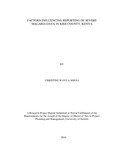| dc.description.abstract | In Kenya, malaria is a major public health concern and fighting the disease is a
National priority requiring a focused, comprehensive and consistent approach because
three-quartes of the population is at risk of malaria. The study adopted a crosssectional
descriptive survey design. The purpose of this study is to determine the
factors influencing the reporting of severe malaria data in Kisii County, Kenya.
Specifically the study looks into training of health workers on DHIS2, ICT
infrastructure, staffing levels and availability of data collecting and reporting tools
(in-patient registers). The data was collected using questionnaires and focused group
discussions. The target population was the members of the County, Sub-county and
hospital health management teams in all the nine sub-counties in Kisii county
whereby a total of 51 fully completed questionnaires were received for data entry.
The data collected was analysed quantitativelly using Statistical Package for Social
Sciences (SPSS). The study found out that about a third (31.4% ) of the respondents
said that the training of health workers on DHIS2 had to a great extent influenced the
reporting of severe malaria data, almost half (47%) of the respondents reported that
the ICT infrastructure had to a great extent influenced the reporting of severe malaria
data at their level, over three quarters (82.3%) of the respondents said that staffing
level contributed to the lack of reporting of severe malaria data to a great extent.
Moreover, the results indicates that over three quarters (78.4%) of the respondents
agreed that the availability of the in-patient registers had to a great extent contributed
to improvement in reporting of severe malaria data. The study then concluded that
reporting of the severe malaria data was determined by many factors that included
availability of infrastructure and training of health workers. The study recommends
that the County government ensures that all HMTs are trained on DHIS and that it
should facilitate the HMTs with computers and internet connectivity for smooth
running of data documentation. It further recommends that the county government to
balance the work force for proper service delivery and embrace performance contract
for all the health workers. | en_US |



